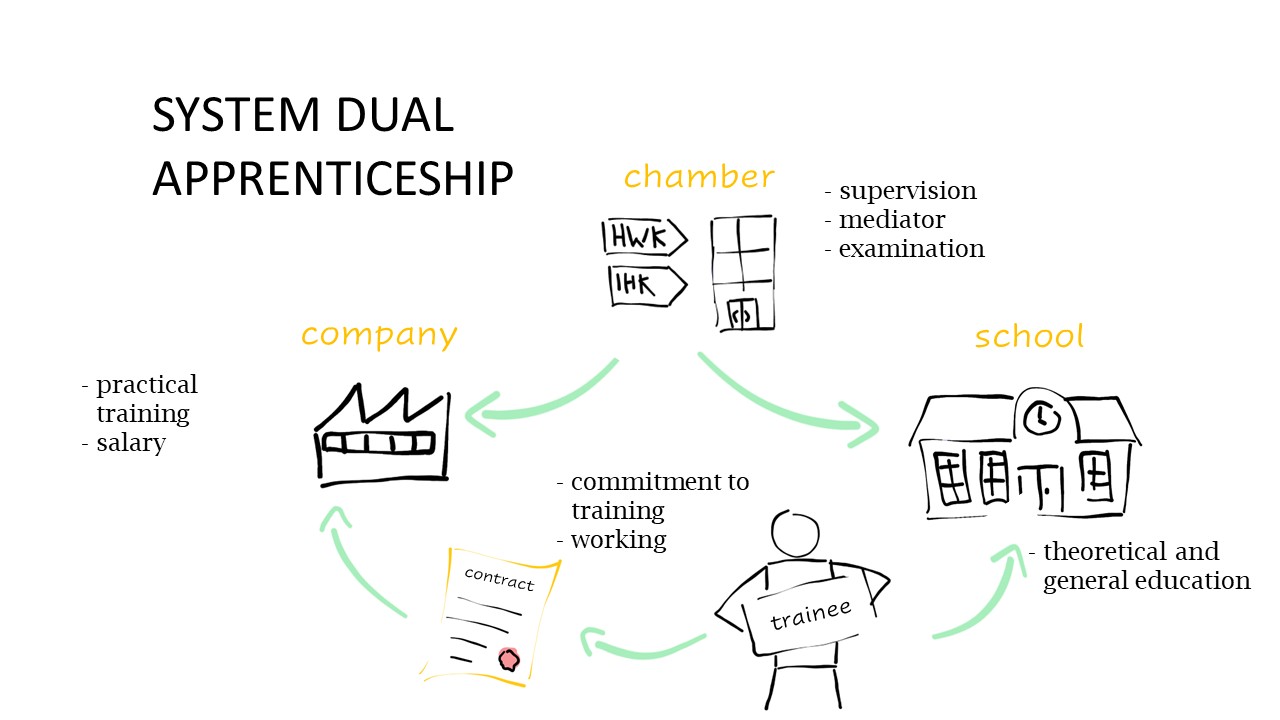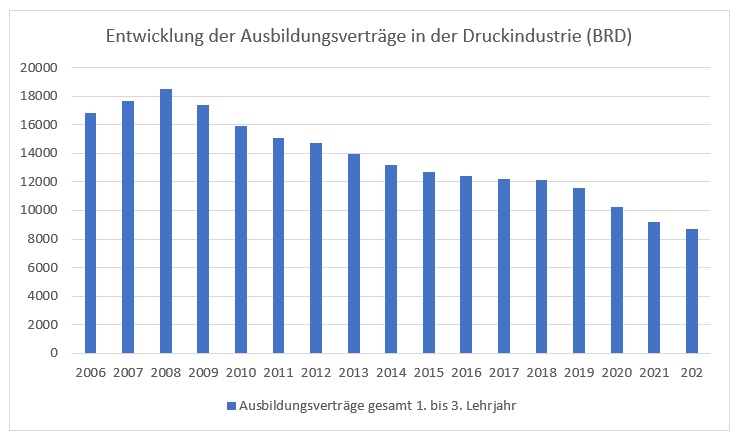P3 5-6/2023 en
What Does it Mean ...
Dual Vocational Training in Germany
Education Gap

One of the big challenges these days is securing the next generation of specialists. The departure of the baby boomer generation from the labor market is likely to leave large gaps in the workforce of the printing and packaging industry. According to press release No. 330 from August 2022 from the Federal Statistical Office, this group includes almost 12.7 million employees in Germany.
The combination of automation and career changers cannot replace basic training.
At the same time, we are observing a sharp decline in training contracts in the industry. The statistical report of the Central Technical Committee for Vocational Training in Print and Media (ZFA) for the 2022/2023 training year from July 2023 shows a decrease of 5.42% in the total number of training contracts in the printing and media sector compared to the previous year. This currently corresponds to 8,723 contracts nationwide. In the 2006 reporting year, for example, there were still 16,857 training contracts.
The dual principle
The next generation of skilled workers will be one of the major challenges of the future. The automation and qualification of career changers helps to close gaps, but does not replace basic training. Dual training is one of the cornerstones of supplying the labor market with young talent. A good opportunity to take a look at this system and highlight current developments. The term dual training refers to the combination of the two learning locations, a training company and a vocational school. The training work is shared between these two partners. In this context, practical and theoretical training is often spoken of. This classification is not entirely correct, because the training companies are also required to impart company-specific theoretical content. In return, practical activities are taught at the vocational school in device-supported lessons. The training content can be found in transnational training regulations and framework curricula. These so-called regulatory means are created under the direction of the Federal Institute for Vocational Training in joint commissions made up of representatives of employers, employees and teachers.
The third partner is the chambers. The Chamber of Industry and Commerce (IHK) and the Chamber of Crafts (HWK) are responsible for commercial and technical professions. Belonging to one of these chambers depends on the type and activity of the company. The chambers act as a higher authority in vocational training. They advise their companies on questions regarding training implementation, monitor the training process and take the exam. At the same time, the chambers are the contact point and mediator in the event of serious imbalances in training.
The advantages of the dual system over purely school-based vocational training lie in the close integration of those involved. The trainees receive a real insight into everyday working life right from the start. The training times are divided into approx. 2/3 in the training company and 1/3 in the vocational school. Depending on the professional field and the catchment area, there are essentially two models of schooling at vocational schools. The weekly model is often chosen if the distance between the company and the school is rather short. The trainees attend school for two days and work in the company for three days. In contrast, there is the block model with two to three week training periods. In between, the trainees spend around 6 to 8 weeks in the company. Particularly in catchment areas that span several federal states, it is difficult to avoid block teaching. In addition to the frequently occurring professional groups, such as in the commercial sector, there are many specialists, such as opticians or screen printers. In this case, individual vocational school locations are often commissioned to form state or federal specialist classes in order to obtain a sufficient number of students.
Training in the company
If a company wants to provide training, the first route is to the responsible IHK or HWK. There you can get all the necessary information about the professional fields, examination procedures, vocational school locations and training requirements. In principle, the desired training occupation can also be trained in your own company. This includes the proven suitability of the training person, the depiction of the professional environment and, if necessary, the necessary technical equipment. The Vocational Training Act (BBiG) and the Trainer Suitability Ordinance (AEVO) define the requirements for the future training person. According to §28 BBiG, anyone who meets the personal and professional requirements for training is suitable. Educational institutions and chambers offer various qualification courses in order to obtain qualifications as trainers. This so-called “training of trainers”, also known as the AdA course, entitles you to take part in the training after successful completion. For freelance professions such as doctors, lawyers, etc., a completed degree is a valid requirement. Only those who have passed the master's examination in the relevant profession are allowed to train in the craft sector. For initial orientation, it helps to talk to business partners who are already providing training, to visit career and educational fairs, or to attend open days at vocational schools.
Finding trainees
Once all the formalities have been completed, the real challenge begins: finding suitable applicants. The observations on the training market are rather worrying. In Germany, training seems to be increasingly unattractive for young people. For years, the supply of training places in Germany has exceeded demand. According to an analysis by Statista, the number of jobs available in 2022 was 544,012. 497,829 positions were filled. That makes a difference of almost 50,000 unfilled training places; a new record value. At the same time, the number of new students is increasing. According to Statista, the student enrollment rate in 2022 was 54.7%. In comparison, it was 33.3% in 2000. The student entry rate is the proportion of the population of each birth cohort that starts studying. This means that every second person initially aims to study. Added to this are the dropout numbers, which are stagnating at a high level. According to the German Center for University and Science Research (DZHW), dropout rates are highest in the natural sciences and engineering sciences. For the graduating class of 2020, for example, this was almost 50% in the natural sciences and 35% in engineering. In return, there is a large proportion of young people who leave school without any qualifications. According to Statista's analysis of the 2021 graduating class, 47,490 people left a general education school without a qualification.
A comparison of the numbers shows which areas need to be searched. From an economic point of view, the above-mentioned dropout rates are unacceptable both at general schools and at universities. A targeted approach to potential applicants shows the greatest success. A meaningful requirements profile and a detailed job description help to avoid misconceptions and arouse the interest of future trainees. Participating in career fairs or orientation days at general schools helps enormously in establishing personal contacts. In addition, the numerous offers from employment agencies, educational institutions, chambers and trade unions as well as regional platforms from business associations should be used intensively.









